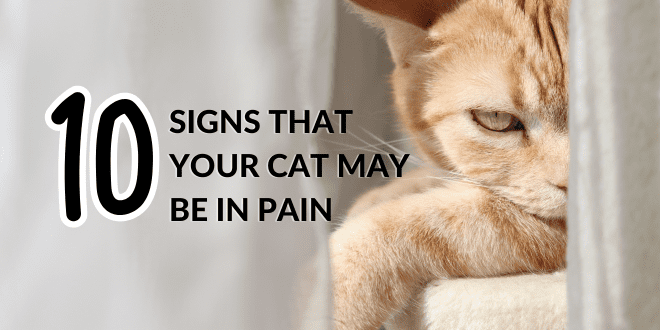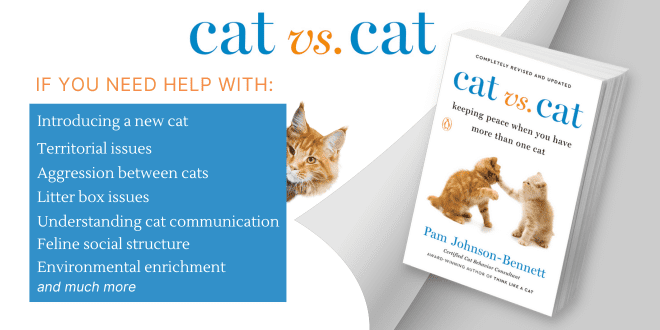
Cats are very stoic and it’s easy for human family members to miss signs of pain or discomfort. For an animal, it’s also important for survival to not display signs of physical weakness, if at all possible.
When you are in pain, the doctor or nurse will ask you to rate your pain on a scale of 1-10. With children, they may use the self-assessment scale that has different facial expressions to help a child better communicate the level of pain. Being able to quickly identify how bad the pain is and where it’s located, aids in diagnosis and in relieving the suffering. Your cat can’t communicate to you and verbally describe the location and level of pain. Your cat can’t even point to the spot on his body the way a young child could. It’s important for you to pay attention to physical signs as well as changes in behavior, personality, or routine that could possibly be a red flag. If you suspect your cat is in pain, please don’t hesitate to get him to the veterinarian.
Here are 10 signs that your cat may be in pain. This is not an all-inclusive list but just a way to get you started on being more observant.
1. Increased Vocalization or Change in the Sound of Vocalization
Your cat may normally be vocal but you may now notice an increase in vocalization or changes to the tone or intensity of the meows. They may now sound more like crying or they may be more frequent. Don’t ignore changes in vocalization and just label your cat as becoming whiny.
2. Licking a Particular Area of the Body
Cats are famous for how much they groom, but if you notice your cat is focusing on a particular area of the body it could be an attempt at relieving pain in that one spot. You might not notice the actual grooming but you may see less fur in that spot or even a bald patch. The increased grooming may cause your cat to have hairballs so pay attention to any increase there as well.
3. Change in the Appearance of the Eyes
You might see the appearance of the nictitating membrane. This is a thin film that may cover the eye or may just be partially visible. With pain, the cat may begin squinting or start keeping eyes closed totally.
4. Hiding and Withdrawal From Family
If you notice your cat becoming more withdrawn or hiding more, it could be an indication of pain. If your cat is normally very social, an increase in hiding is easier to spot but if your cat is timid and tends to hide, it can be more difficult. Your cat may normally be very affectionate and now you’ve noticed he doesn’t want to be on your lap or no longer does much facial rubbing. The cat may now prefer staying in darkened rooms.
5. Panting or Open Mouth Breathing
Open mouth breathing is an emergency. This is not a normal way of breathing so don’t ignore this physical sign. This could indicate extreme pain or difficulty breathing. open mouth breathing is an emergency.
6. Irritability, Grumpiness or Overall Mood Change
This may be a general grumpiness or it could be short-tempered behavior displayed as aggression when touched. There are certain areas of the body that are sensitive to most cats, such as the tummy, but you know your cat so you know where you’ve always been allowed to stroke. If there’s a display of aggression or even groaning or growling when you touch a spot, it could be a sign your cat is hurting there. The signs of potential pain may be far less obvious though; it might be just a general change in mood or personality.

Photo: Pam Johnson-Bennett
7. Lack of Appetite
This is easier to notice if you feed your cat on a schedule rather than free-feed, but it’s important to pay attention to changes in appetite. This is just one of the reasons I have always recommended scheduled meals. If you have a multicat household, use individual bowls so you can monitor how much each cat gets. If you just put out one big food bowl in a multicat home, you have no way of knowing who is eating and who isn’t until obvious signs of weight loss or gain are physically visible.
8. Change in Posture or Mobility
Is your cat normally active and playful and now you can’t get him interested in chasing a favorite toy? Perhaps your cat used to love to climb to the top of the cat tree to watch the birds outdoors but you notice he hasn’t been in the tree for a while or it takes longer to climb there. Those are warning signs of potential pain. A hunched posture is also a typical sign of pain but can easily be missed if you don’t pay attention to how your cat normally stands or walks. Limping is another obvious sign. A sign that isn’t as obvious is shifting of position. The cat may be trying to relieve discomfort when standing or sitting by shifting weight. If reclining, the cat may switch from one side to the other in an effort to find a position less painful. Reluctance to move at all is also a possible sign of pain.
9. Change in Litter Box Habits
This means any change at all, including an increase or decrease in use. Your cat may make frequent trips to the litter that are or aren’t productive. Your cat may stay in the box for longer than is typical. You may hear vocalization while in the box. Some cats normally do meow while in the box so it’s important to know your cat’s typical routine. You may notice an increase in meowing a change in tone that sounds like a cry or sounds more urgent. You might notice urine or feces on the carpet or floor where your cat hasn’t made it in time to the box. While in the box, you may see kitty appear to be straining to eliminate. He might now be avoiding the box totally. It’s common for cats to associate the box itself with the pain they feel upon elimination attempt.
Pay attention to the size and appearance of what gets deposited in the box. Changes in the amount, appearance, or smell of urine could indicate an underlying medical problem and that probably means your cat is in pain. When it comes to solid waste, take a look at it before just scooping it up for disposal. Does it look different? Does it seem slimy? Does the color or odor seem a little different? Signs of constipation? Diarrhea? Changes in your cat’s urine and feces could indicate an underlying problem and that also means pain is likely involved. Taking a few seconds to look at your cat’s waste before disposing of it may not be pleasant but it’s actually an important way of monitoring health.
10. Increased Clingy/Needy-Type Behavior
Some cats are normally very physically affectionate and even clingy and some are more content with a quick stroke or very limited physical closeness. Again, you know your cat’s personality and normal behavior so be mindful of changes. It’s easy to just sit back and enjoy a reluctant cat’s sudden desire to constantly be in your lap but it may mean your cat is seeking comfort from pain.
Your Cat is Depending on You
Many signs of potential pain can be very subtle and easily missed. For example, if you aren’t routinely scooping the litter box twice a day you’ll miss the fact that your cat hasn’t urinated or defecated in there for a day or two.
If your normally friendly cat starts becoming short-tempered, don’t write it off as kitty just being in a bad mood. Increased or uncharacteristic aggression is a common sign of pain. With an older cat, don’t just assume a change in activity or personality is just a sign of old age. It could very well indicate pain from something like arthritis.
Cats are creatures of routine and a change in behavior can be a warning sign of something medically wrong. Don’t play wait-and-see when it comes to your cat’s health. Your cat may be communicating in the best way he knows how that he’s hurting and needs help.
Need More Information?
If you have a question about your cat’s change in behavior, litter box habits, appetite, water intake, appearance, or anything else, contact your veterinarian.
For more information on cat behavior and training, refer to the books by Pam Johnson-Bennett. Pam’s books are available at bookstores and online. We’ve included links to Amazon here on our website.
This article is not intended as a medical diagnosis nor is it a replacement for your cat’s regular veterinary care. This article is for general information purposes only.
 Problem Solving & Advice by Pam Johnson-Bennett Cat Behavior Expert & Best-selling Author
Problem Solving & Advice by Pam Johnson-Bennett Cat Behavior Expert & Best-selling Author





